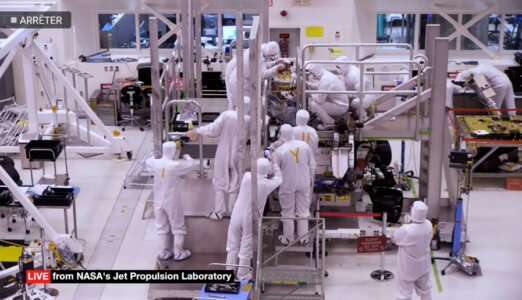SuperCam instrument integrated on NASA's Mars 2020 rover

The French/American SuperCam instrument has been delivered early June to NASA's Jet Propulsion Laboratory and has been integrated this week on NASA's Mars 2020 rover. The French space agency, CNES, together with university institutes in France, developed the multi-purpose camera to remotely analyze minerals, chemistry, sounds, and test for compounds associated with life, together with the Los Alamos National Laboratory (US). The announcement of the integration was made during the annual meeting of the European Astronomical Society (EWASS2019) in Lyon, that takes place 24-28 June.
Tomorrow, 28 June, Sylvestre Maurice from IRAP (Toulouse, France) will introduce in his presentation in the SS13 session several past and future analyses carried out on the surface of Mars.
In 2014, Sylvestre Maurice presented together with Roger Wiens (Los Alamos Laboratory) an upgraded version of ChemCam for the next NASA rover, March 2020. Selected by NASA as the SuperCam, this instrument will take chemical analysis and embark on new ways of Raman and Infra-red measurement for the mineral composition of Mars. The March 2020 mission aims to determine whether life has developed on the surface of Mars and to prepare a set of samples that will be brought back to Earth in future Martian missions, called sample return missions. The Mars 2020 mission will be launched in July 2020.
SuperCam is a souped-up version of ChemCam, which is currently operating aboard the Mars Curiosity rover. ChemCam data has revolutionized our understanding of the geology and atmosphere of Mars, having quantified abundances of elements as rare as lithium and boron as well as making discoveries with more abundant elements in over half a million spectra sent back from the red planet. Its discoveries have contributed to our current understanding of Mars as a once warmer and habitable planet.
SuperCam, with its expanded remote-sensing analysis tools, will yield even more detail than ChemCam about the mineralogy and the presence of compounds related to the possibility of life on the surface of Mars.
Developed jointly by the Los Alamos National Laboratory and the French space agency, CNES, University laboratories in France, the instrument is ambitious. It combines different techniques at remote distances: Laser Induced Breakdown Spectroscopy (LIBS) for elemental composition, infrared (IR) and Raman spectroscopy, color imaging, and even sound recording through a microphone. NASA called it a "Swiss army knife" of instruments because of its versatility.
The Mars 2020 rover is set to be launched July 2020 and to land within Jezero Crater, Mars, in February 2021. The primary goal of the mission is to search for traces of life in situ, and to prepare samples for their return to Earth in a near future (aka the Mars Sample Return mission).
Provided by EWASS





















